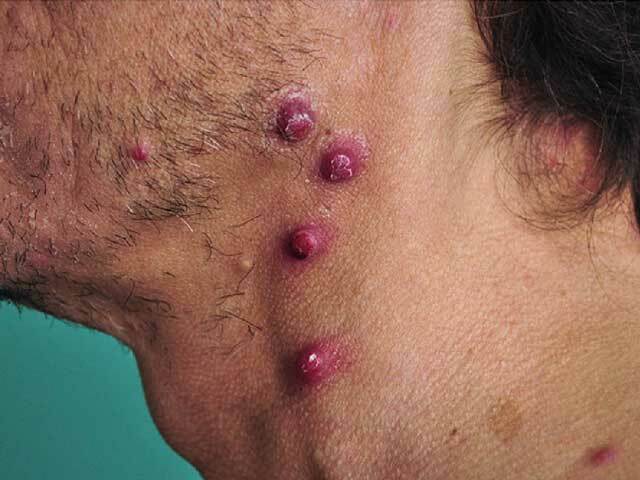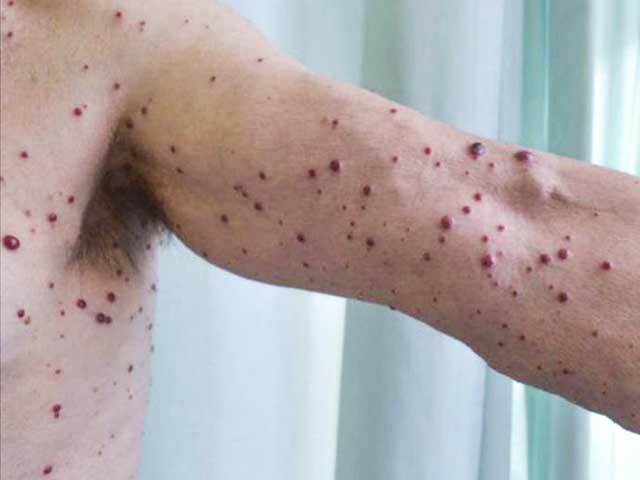Main menu
Common skin conditions

NEWS
Join DermNet PRO
Read more
Quick links
Bacillary angiomatosis — extra information
Bacillary angiomatosis
Author: Vanessa Ngan, Staff Writer, 2003. DermNet Update August 2021
Introduction
Demographics
Causes
Clinical features
Complications
Diagnosis
Differential diagnoses
Treatment
Outcome
What is bacillary angiomatosis?
Bacillary angiomatosis is an opportunistic cutaneous and systemic bacterial infection caused by Bartonella quintana and Bartonella henselae usually affecting immunocompromised patients.
Who gets bacillary angiomatosis?
Bacillary angiomatosis is seen predominantly with drug-induced immunosuppression, particularly organ transplant recipients, chronic lymphocytic leukaemia, and those with HIV/AIDS. However, otherwise healthy individuals, including children, can also contract the infection such as after major local trauma.
What is the cause of bacillary angiomatosis?
Bacillary angiomatosis is caused by Bartonella (Rochalimaea) quintana and Bartonella (Rochalimaea) henselae, gram-negative intracellular bacteria. Cats are the main reservoir for B henselae, and humans for B quintana. While cat bites and scratches can transmit the infection, fleas are the primary means of transmission, with ticks also serving as a potential vector. B quintana is transmitted by the human body louse (Pediculus humanus) and fleas.
What are the clinical features of bacillary angiomatosis?
Skin lesions are usually the first manifestation of bacillary angiomatosis.
- Papules and nodules, range in size from pinpoint to 10cm
- Purple, violaceous, or bright red in colour
- Single lesion or many hundreds
- Any skin or mucosal site can be involved, although rarely the palms and soles
- In HIV, large subcutaneous tumours may form
- Lesions may bleed easily
- Overlying skin surface may become ulcerated or crusted
Skin lesions of bacillary angiomatosis in transplant recipients

Bacillary angiomatosis in a transplant recipient

Bacillary angiomatosis in a transplant recipient

Bacillary angiomatosis in a transplant recipient
As the number of skin lesions increase, the patient may develop high fever, tender swollen lymph nodes, nausea, vomiting, sweats, chills, and poor appetite.
How do clinical features vary in differing types of skin?
Hyperpigmented indurated plaques have been described mainly in skin of colour.
What are the complications of bacillary angiomatosis?
The infection can cause blood vessels to grow out of control and form tumour-like masses in other organs including the brain, bone, gastrointestinal tract, and respiratory tract with airway obstruction.
Liver involvement is called 'peliosis hepatis' or 'bacillary peliosis'.
How is bacillary angiomatosis diagnosed?
Bacillary angiomatosis should be suspected clinically, particularly in an immunocompromised patient.
Skin biopsy shows lobular blood vessel proliferation with epithelioid endothelial cells, and an inflammatory infiltrate including neutrophils. The microorganisms can be seen as basophilic clumps in the stroma and confirmed on Giemsa or Warthin-Starry stain. [see Bacillary angiomatosis pathology]
Polymerase chain reaction (PCR) can be used to identify the causative agent.
What is the differential diagnosis of bacillary angiomatosis?
What is the treatment of bacillary angiomatosis?
- Erythromycin 500mg qid
- Doxycycline 100mg bd
- Other antibiotic options include trimethoprim + sulphamethoxazole, tetracycline, rifampicin
Antibiotics should be continued for 3-6 months to prevent recurrence.
Large pus-filled lymph nodes or blisters may need to be drained. Supportive therapy includes hydration and analgesics for pain and fever. Warm moist compresses to affected nodes may decrease swelling and tenderness.
What is the outcome of bacillary angiomatosis?
Cutaneous lesions of bacillary angiomatosis disappear with days to weeks of starting appropriate treatment, although response can be incomplete.
Spontaneous resolution has been reported.
Systemic bacillary angiomatosis can be fatal if not treated promptly.
Bibliography
- Balaban M, Ioana Nedelcu R, Balmes G, et al. Bacillary angiomatosis triggered by severe trauma in a healthy Caucasian patient: A case report. Exp Ther Med. 2020;20(1):56–60. doi:10.3892/etm.2019.8260 PubMed Central
- Brzewski P, Kwiecińska M, Sułowicz J, et al. Bacillary angiomatosis in renal transplant recipient: a case report. Transplant Proc. 2020;52(8):2524–6. doi:10.1016/j.transproceed.2020.02.092 Journal
- Helleberg M. Bacillary angiomatosis in a solid organ transplant recipient. IDCases. 2019;18:e00649. doi:10.1016/j.idcr.2019.e00649. Journal
- Mohanlal R, Reddy DL. Spectrum of HIV-associated infectious diseases: a case series through the eyes of the histopathologist. South Afr J HIV Med. 2020;21(1):1087. doi:10.4102/sajhivmed.v21i1.1087. PubMed Central
- Orsag J, Flodr P, Melter O, et al. Cutaneous bacillary angiomatosis due to Bartonella quintana in a renal transplant recipient. Transpl Int. 2015;28(5):626–31. doi:10.1111/tri.12539. Journal
On DermNet
- Bacillary angiomatosis pathology
- Cat scratch disease
- Drug-induced immunosuppression
- Skin conditions relating to HIV infection
Other websites
- Dermatologic Manifestations of Bacillary Angiomatosis — Medscape Drugs & Diseases
